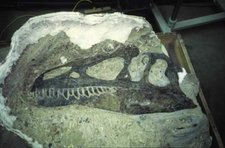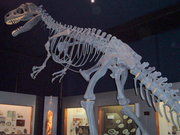Allosaurus
Allosaurus (AL-oh-sore-us) meaning “different lizard”, because its vertebrae were different from those of all other dinosaurs (Greek allos = different + sauros = lizard), was a large carnivorous dinosaur with a length of up to 12 m (39 ft). more...
It was the most common large predator in North America, 155 to 145 million years ago, in the Jurassic period.
Allosaurus is the official state fossil of Utah, in the United States.
Description
Allosaurus is a classic big theropod: a big skull on a short neck, a long tail, and reduced forelimbs. Its most distinctive feature is a pair of blunt horns just above and in front of the eyes. Although short in comparison to the hindlimbs, the forelimbs are massive and bear large, eagle-like claws. The skull shows evidence of being composed of separate modules, which could be moved in relation to one another, allowing large pieces of meat to be swallowed. The skeleton of Allosaurus, like other theropods, shows birdlike features like a wishbone and neck vertebrae hollowed by air sacs. It is thought that Allosaurus might have hunted in packs, allowing it to bring down the large sauropods of the time. Allosaurus was extremely light compared to other dinosaurs its size, which may have allowed it to leap onto its prey (something that only small dinosaurs could do) without sustaining severe injury.
Findings
Allosaurus is the most common theropod in the huge section of dinosaur-bearing rock in the American Southwest known as the Morrison Formation. Remains have been recovered in Montana, Wyoming, South Dakota, Colorado, Oklahoma, New Mexico, and Utah in the United States; and in Portugal. Curiously, Allosaurus shared the Jurassic landscape with several other theropods, including Ceratosaurus and the massive Torvosaurus.
A famous fossil bed can be found in the Cleveland Lloyd Quarry in Utah. This fossil bed contains over 10,000 bones, mostly of Allosaurus, with other dinosaurs like Stegosaurus and Ceratosaurus thrown in. It is still a mystery how the remnants of so many animals can be found in one place: normally the ratio of fossils of carnivorous animals over fossils of plant eaters is very small. Findings like these can be explained by pack hunting, although this is difficult to prove.
One of the more significant finds was the 1991 discovery of "Big Al" (MOR 593), a 95% complete, partially articulated, juvenile specimen that measured 8 meters (26 feet) in length. Nineteen bones were broken or showed signs of infection, which probably contributed to Big Al's death. It was featured in the BBC's Walking with Dinosaurs series in the "Ballad of Big Al". The fossils were excavated near Shell, Wyoming by the Museum of the Rockies and the University of Wyoming Geological Museum. This skeleton was initially discovered by a Swiss team led by Kirby Siber, which later excavated a second Allosaurus "Big Al Two", which is the best preserved skeleton of its kind to date.
Read more at Wikipedia.org



